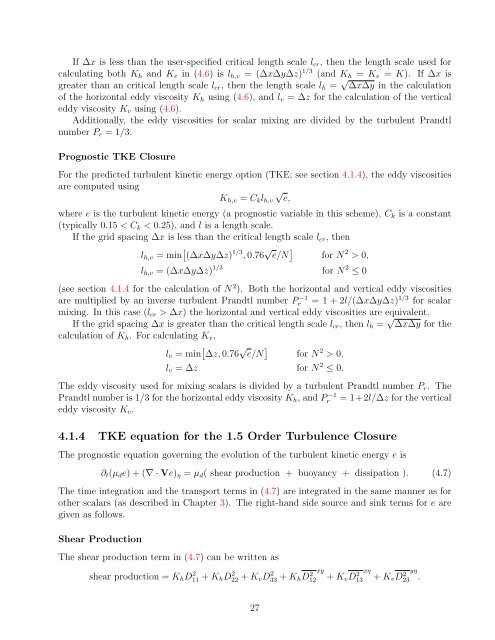Advanced Research WRF (ARW) Technical Note - MMM - University ...
Advanced Research WRF (ARW) Technical Note - MMM - University ...
Advanced Research WRF (ARW) Technical Note - MMM - University ...
Create successful ePaper yourself
Turn your PDF publications into a flip-book with our unique Google optimized e-Paper software.
If ∆x is less than the user-specified critical length scale lcr, then the length scale used for<br />
calculating both Kh and Kv in (4.6) is lh,v = (∆x∆y∆z) 1/3 (and Kh = Kv = K). If ∆x is<br />
greater than an critical length scale lcr, then the length scale lh = √ ∆x∆y in the calculation<br />
of the horizontal eddy viscosity Kh using (4.6), and lv = ∆z for the calculation of the vertical<br />
eddy viscosity Kv using (4.6).<br />
Additionally, the eddy viscosities for scalar mixing are divided by the turbulent Prandtl<br />
number Pr = 1/3.<br />
Prognostic TKE Closure<br />
For the predicted turbulent kinetic energy option (TKE; see section 4.1.4), the eddy viscosities<br />
are computed using<br />
√<br />
e,<br />
Kh,v = Cklh,v<br />
where e is the turbulent kinetic energy (a prognostic variable in this scheme), Ck is a constant<br />
(typically 0.15 < Ck < 0.25), and l is a length scale.<br />
If the grid spacing ∆x is less than the critical length scale lcr, then<br />
lh,v = min (∆x∆y∆z) 1/3 , 0.76 √ e/N <br />
for N 2 > 0,<br />
lh,v = (∆x∆y∆z) 1/3<br />
for N 2 ≤ 0<br />
(see section 4.1.4 for the calculation of N 2 ). Both the horizontal and vertical eddy viscosities<br />
are multiplied by an inverse turbulent Prandtl number P −1<br />
r = 1 + 2l/(∆x∆y∆z) 1/3 for scalar<br />
mixing. In this case (lcr > ∆x) the horizontal and vertical eddy viscosities are equivalent.<br />
If the grid spacing ∆x is greater than the critical length scale lcr, then lh = √ ∆x∆y for the<br />
calculation of Kh. For calculating Kv,<br />
lv = min ∆z, 0.76 √ e/N <br />
for N 2 > 0,<br />
lv = ∆z for N 2 ≤ 0.<br />
The eddy viscosity used for mixing scalars is divided by a turbulent Prandtl number Pr. The<br />
Prandtl number is 1/3 for the horizontal eddy viscosity Kh, and P −1<br />
r = 1+2l/∆z for the vertical<br />
eddy viscosity Kv.<br />
4.1.4 TKE equation for the 1.5 Order Turbulence Closure<br />
The prognostic equation governing the evolution of the turbulent kinetic energy e is<br />
∂t(µde) + (∇ · Ve)η = µd( shear production + buoyancy + dissipation ). (4.7)<br />
The time integration and the transport terms in (4.7) are integrated in the same manner as for<br />
other scalars (as described in Chapter 3). The right-hand side source and sink terms for e are<br />
given as follows.<br />
Shear Production<br />
The shear production term in (4.7) can be written as<br />
shear production = KhD 2 11 + KhD 2 22 + KvD 2 33 + KhD2 xy<br />
12 + KvD2 xη<br />
13 + KvD2 yη<br />
23 .<br />
27
















